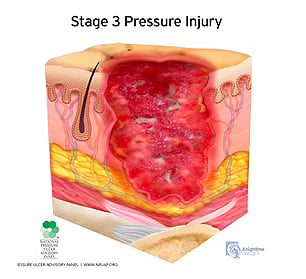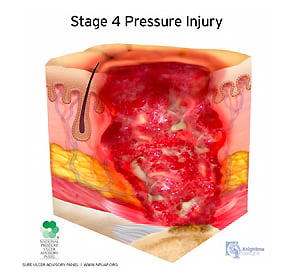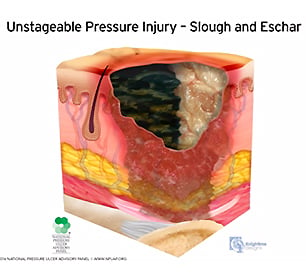Medical patients often want to know what’s happening to their bodies, how they’re being cared for, and how they can help! And when it comes to hospital-acquired pressure injuries, treatment can demand a lot from both patients and their caregivers. Cutting through medical jargon can help patients understand their needs and expectations, and enlist them as active participants in their own healing.

But when you’re dealing with the many demands of a busy shift, it’s easy to find yourself at a loss for words. To help with those moments, we’ve compiled this quick reference guide with some simple ways to explain pressure injury stages and prevention and treatment options to your patients.
What are pressure injuries?
Often called “bedsores”, pressure injuries can be described in layperson’s terms as areas of skin that are damaged after being compressed for too long. This happens when the body doesn’t shift positions enough, often while someone is partially immobilized through injury or post-operative healing.
This damage also extends to include the soft tissue, like muscles, underneath it. These injuries often develop over areas where the bone lies closer to the skin surface.
While damage is confined to one area, pressure injuries can grow in size and get worse if the wound is left untreated. These wounds are classified in stages, ranging from the shallowest wound with the least damage (stage 1), to wounds which deepen all the way down to the bone (stage 4).
Stage 1–2 pressure Injuries
Stage 1 pressure injuries are the least severe, though they can still be painful. Some parts of the skin haven’t developed an ulcer yet, but the skin is red in color. In other parts of the wound, skin has thinned. In some cases, a fluid-filled blister may form.
.jpg?width=306&name=Image_1%20(1).jpg)
With stage 2 pressure injuries, the damage is more severe. These carry all the signs of a stage 1 pressure injury with a few additions. While fat and deeper tissues aren’t visible, the wound bed is pink or red, and moist. The outer layer of skin (epidermis) has also been worn through in places to expose the dermis — the layer of skin in which blood vessels and nerve endings are found.
.jpg?width=306&name=Image_2%20(1).jpg)
Stage 3–4 pressure Injuries
Stage 3 and stage 4 pressure injuries are the most severe. A stage 3 pressure injury’s wound has deepened until fat is visible, though the depth of this injury may vary depending where it is on the body. Dead and dying tissue (slough and eschar) may be visible.

At stage 4, a pressure injury ulcer exposes layers of muscles, tendons, cartilage or bone. Like stage 3 injuries, the edges of the wound are rolled, and slough and eschar may be visible.

For more detailed information about pressure injury stages (for the more curious patient), check out our blog post, A Nurses Visual Aid for Illustrating Pressure Injury Stages.
Unstageable pressure injuries
These pressure injuries can’t be categorized, because dead and dying tissue prevents you from seeing the extent of the damage. If this tissue can be effectively removed, the injury will either be at stage 3 or stage 4.

How to discuss preventing and treating the different pressure injury stages
Discussing prevention and treatment in practical terms can benefit both the patient and caregivers. When patients know how treatments will help, they can take a more active part in their healing, making a caregiver’s job that much easier.
When discussing how you’ll address the risk of pressure injuries, or treat an existing one, it pays to keep things simple. Highlight how their therapeutic support surface reduces excess pressure on vulnerable areas of their body, and controls the skin’s microclimate to prevent pressure injuries from forming or worsening.
Related: See our resource on pressure injury prevention & treatment in healthcare facilities.
AirisanaTM joins forces with patients and caregivers to reduce pressure injuries
Some products are designed with both patients and caregivers in mind, and an interested patient may even ask questions about the specific technology. Here’s how you might introduce the Airisana™ therapeutic support surface to the curious:
AirisanaTM was developed to help prevent pressure injuries without getting in the way of other bedside therapies. This means that preventing and treating a pressure injury doesn’t have to get in the way of physical therapy, for example.
Things like randomized pressure therapy modes stop the body getting used to alternating pressure patterns, and targeted airflow prevents overly-drying healthy skin — two ways Airisana™ addresses pressure injuries without unnecessary side effects.
Airisana™ makes treating and preventing pressure injuries as effortless as explaining what they are — without compromising on the cutting-edge science behind it.
Learn more about this revolutionary approach to pressure injury treatment and prevention by clicking the button below.


